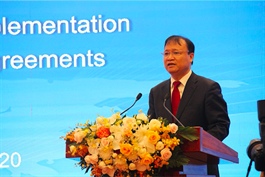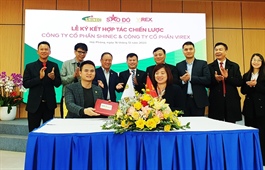ICT foes jostle for pole position in tech race
ICT foes jostle for pole position in tech race
Bolstered by growing new interest and motivations, Vietnam’s tech market could see a new boom in the months to come, with the order of the playground expected to change among domestic and international players.

As mobile phone usage explodes in Vietnam, online shopping and other services become more advanced, Photo: shutterstock
|
HCL Technologies, one of the three largest Indian IT groups, at last week’s meeting with the Ministry of Information and Communications (MIC), announced that it will open an office in Hanoi in January, with the plan to increase its staff to 8,000 employees in the next four years.
Sanjay Gupta, corporate vice president of HCL, expressed his ambition to turn Vietnam into the company’s largest IT hub in Southeast Asia, developing and using Vietnamese human resources and high-tech services for multinational corporations.
To realise this, HCL has been cooperating with local universities like Hanoi University, Thai Nguyen University, and others in IT training.
Growing interest
At the fourth Japan-Vietnam ICT Joint Working Group in early December, a number of Japanese firms, including Allm Inc., Fujitsu, NTT DoCoMo, and Softbank, expressed their interest in supplying 5G solutions and services.
Elsewhere, international venture funds are rushing to exploit the local market by investing in innovative startups. For instance, in late November, Surge – Sequoia Capital India’s rapid scale-up programme for startups – announced the 17 startups selected for Surge 04 2020, including names from Vietnam and Singapore.
Sequoia Capital India is the Indian arm of the US-based investment company, topping the Hurun India Top Unicorn Investors List 2020.
In late November, at the Vietnam Venture Summit 2020, 33 investment funds committed to invest $815 million in startups and innovations in Vietnam in 2021-2025. The event attracted many prominent names like Golden Gate Ventures, Softbank Venture, Sequoia, ADB Venture, and Qiming Venture, proving how attractive the Vietnamese technology market can be to them.
Vietnam has been a magnet to international venture funds in recent years. In 2019, the Vietnam Venture Summit lured over 130 international and 70 domestic funds, 18 of which pledged to invest $425 million in innovative businesses by 2021.
This trend was reinforced by the Politburo’s Resolution No.52-NQ/TW from last year on a number of guidelines and policies to proactively participate in Industry 4.0, the approval of the National Digital Transformation Programme by 2025 with vision to 2030, and the country’s new foreign direct investment (FDI) attraction strategy with high-tech as a focus.
In addition to the new players, traditional giants such as Qualcomm, Ericsson, Dell, Huawei, IBM, and HP are expanding in smart banking, city, manufacturing, and energy development, tapping into the growing demand for digital transformation.
As shown in statistics from the Ministry of Planning and Investment, Vietnam’s total registered FDI in sci-tech and ICT hit about $1.25 billion in the first 11 months of 2020.
ICT now plays an increasing role in the country’s economic development. According to the MIC, the country’s total ICT revenue reached over $112 billion in 2019, thus increasing the GDP contribution of the sector to 5.59 per cent. The figure is expected to rise to 7.3 per cent in 2020, and to even over 16 per cent if foreign-invested contributors are included.
Following the trend
According to Vu The Binh, general secretary of the Vietnam Internet Association, in 2021, there will be some obvious trends in Vietnam. First is the commercial launch of some big telecoms service operators. The launch will be made gradually towards market demands and economic efficiency.
The other trend is the growing demand for bandwidth and supporting services for online jobs as a way for people to adapt to the serious impacts of COVID-19. Moreover, the tendency of using the internet via mobile phones is increasing strongly and will be intensified in the future, resulting in the development of new applications.
Evidently, 5G is the game for the country’s three biggest telecoms service operators of Viettel, VNPT, and MobiFone, as well as for international players like Ericsson, Qualcomm, AWS, Keysight Technologies, Lenovo, and others – all of which are preparing for the nation-wide commercial launch of 5G.
At the forefront of mobile service providers, however, are Viettel, VNPT, and MobiFone, which have gained majority market share, leaving little room for international players.
Regarding the static internet market, Binh told VIR, “There are several operators such as FPT, CMC, Hanoi Telecom, NetNam, and some foreign firms, but generally opportunities for international service operators are not particularly vast.”
“International players may consider to venture further into the market, perhaps by investing in or cooperating with local partners, or by focusing on other service segments that have much more room to develop and compete, such as data centres, cloud services, and others,” Binh elaborated.
Foreign players may also focus on providing equipment, infrastructure, and value-added services, such as developing wireless and alternative broadband technologies, or partnering with established network operators to provide mobile network services.
Additionally, since the satellite-based telecoms market is not yet developed in Vietnam, opportunities are expected for companies to provide these services on a cross-border basis.



























